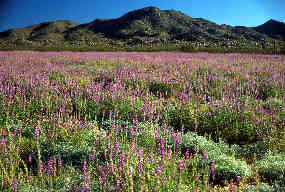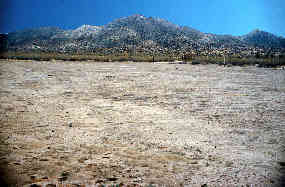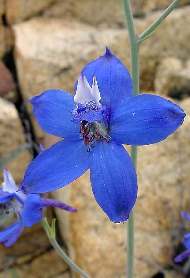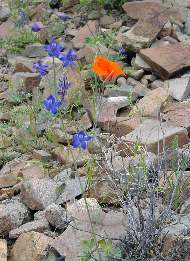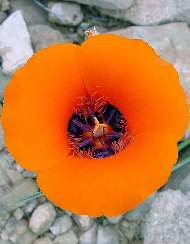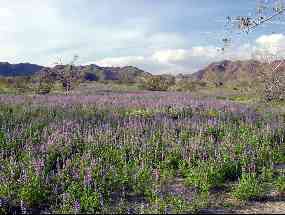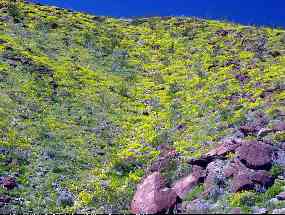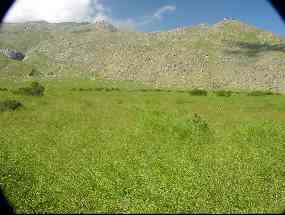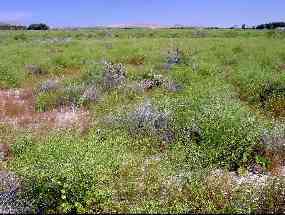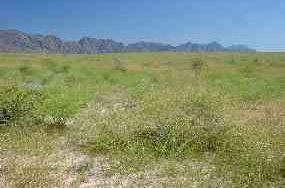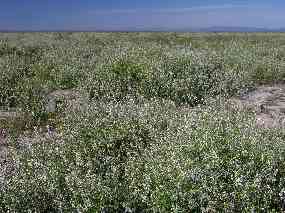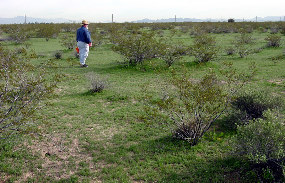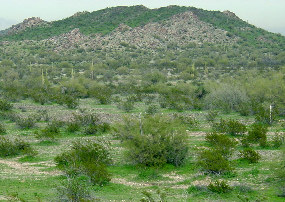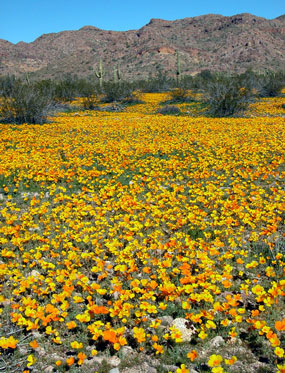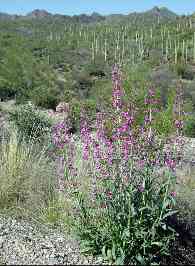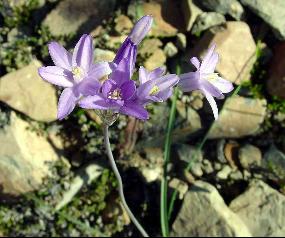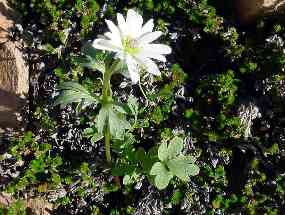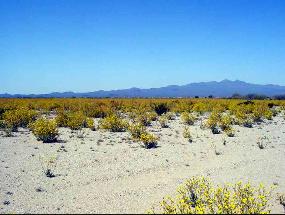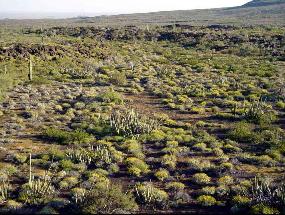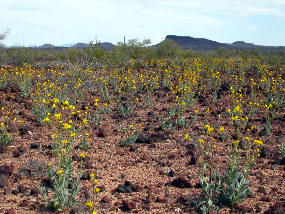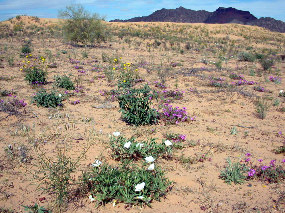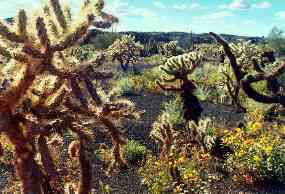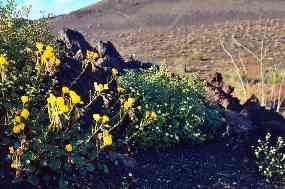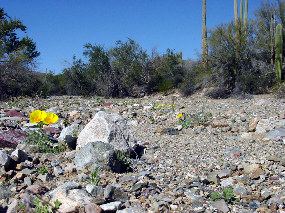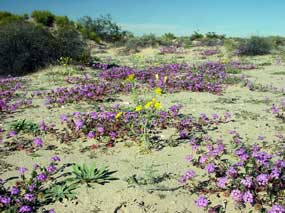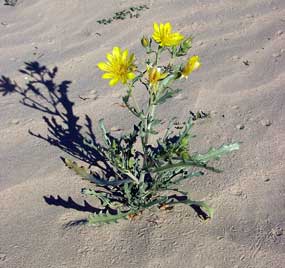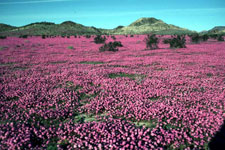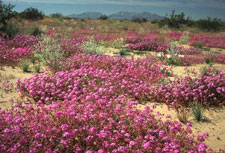|
Desert Wildflower Blooms 2004 / 2005 Desert Wildflower Forecast and Report Note: This page is (1) intended primarily to provide early forecasts for the area around Tucson, Arizona, and of massive, desert-wide blooms and (2) is updated only when we receive information. Desert travelers are encouraged to send their observations of rainfall, greening desert or blooming flowers (good and bad) and images to the email address below. For other sources of current wildflower information in the Southwest deserts, visit the websites listed below.
March 28, 2005 Two of the brightest wildflowers, desert delphinium (Delphinium scaposum) and desert mariposa (Calochortus kennedyi), are now blooming in the Tucson Mountains. The most accessible populations are in King Canyon where they begin less than 100 yards up the trail from the parking lot.
Most annuals are still colorful, but there are few buds left and the foliage is beginning to shrivel. Brittlebush are still a little below peak; ocotillos are just beginning to flower. Very few cacti in flower yet. This may be the final update for this year; the usual and dependable progression of perennial flowers is expected for the rest of the spring. In Arizona Upland Sonoran Desert there will be many species of flowers in bloom throughout April, in greater profusion than in most years. Palo verdes, desert ironwood trees, prickly pears, and saguaros should bloom in May. March 22, 2005 Update on King Canyon in the Tucson Mountains: The delphiniums are in full bloom, but no mariposas yet. The big buds I've been watching have been eaten. The other buds are probably a week away from opening assuming they don't get eaten too. Most annual flowers, brittlebush, and fairy duster still looking very good. March 18, 2005 Special alert: A professional photographer called me from the Pinacate Natural Reserve in Sonora, Mexico today to tell me that the sand dunes are still an incredible sea of flowers, mostly dune evening primrose and sand verbena. Specifically the road into the Sierra del Rosario, where the sand is still wet two inches below the surface. A museum employee toured the lava fields last weekend and said it was still very green and flowery. Tucson Mountains, King Canyon and surrounding hills: Delphinium opened first flowers yesterday; no mariposa yet but any day now. Other herbaceous plants are at peak of color, including silver bells (Streptanthus carinatus), catterpillarweed (Phacelia affinis), Parry penstemon (but rare due to preceeding drought), desert chicory (Rafinesquia neomexicana), desert hyacinth (Dichelostemma capitata), and lupines (Lupinus sparsiflorus). Brittlebush is at peak on roadsides, but just beginning on the hills. Fairy duster (Calliandra eriophylla) is putting on another flush of bloom. Mid March 2005 The low valleys of the Sonoran and Mohave deserts are rapidly drying up though some areas remain in good condition. The floral displays are moving up into the hills above 2500 feet elevation. As of March 10, Cottonwood Canyon in the south side of Joshua Tree National Park was still an extensive carpet of flowers (mostly lupines), at peak color. Higher elevations in the park are probably looking great by now. The floor of Anza-Borrego Desert State Park (CA) was drying up, but the hills were ablaze with poppies (Eschscholzia parishii), especially on the Montezuma Grade (S22). The famous section of AZ 86 near the base of Kitt Peak has large fields of flowers. This year they are almost all poppies (Eschscholzia californica mexicana), at peak color.
Arizona Upland Sonoran Desert around Tucson has not yet peaked. Pichacho Peak State Park (AZ) has only small patches of poppies visible from the freeway (in the best years you can see the mountain glowing orange from several miles away). The low desert this year supported perhaps one-fifth of the flowers that it could in the best years. Most of the valleys, especially the sandy ones, were completely overrun with invasive exotic weeds. Thousands of square miles are covered with Sahara mustard (Brassica tournefortii). Not only has it smothered native flowers, but it is dense enough to carry huge wildfires when it dries. Only the Algodones (Imperial) Sand Dunes in SE CA and the Yuma dunes were spared along I-10 and I-8 in California and Arizona.
Tucson Mountains, Arizona Upland, March 15 (Tucson Mountains County Park and Saguaro National Park West, elev. 3000 feet): Many species in bloom right now. The annuals are a little past peak but still look good. The smaller perennials are mostly at peak; brittlebush is in early peak. Alert: Two of our most intensely-colored wildflowers, desert larkspur (Delphinium scaposum) and desert mariposa (Calochortus kennedyi), are in bud. They will be in bloom in King Canyon within a week and probably in full glory by the first of April. These two bloom only in wet years; this will be the first good showing since 1998. Early March 2005 Gene and Jane report of the Pinacate Natural Park (Sonora) : It's incredible. Drop everything and go NOW. Have never seen it so lush. Michael sends this extensive report on various places in Arizona: Gibraltar Mts. near Parker: near peak with Encelia (brittlebush), Phacelia and Oenothera spp (evening primroses). dominating. Opuntia basilaris in bud. Cactus Plain Wilderness (SE of Parker): overrun with Sahara mustard (Brassica tournefortii). Native sand species presenting a poor show. Palafoxia (Spanish needles), Abronia (sand verbena), and Hesperocallis (Ajo Lilies) looking good in places. Kofa NWR: Looks to be at peak bloom, but rain still falling, so who know how far it will go? Especially verdant around Palm Canyon. Kofa was the most astonishing area I visted. Organ Pipe Cactus NM & Ajo: Annuals not as well developed in the valleys, but a good show at higher elevations, from Santa Elena Canyon to Bull Pasture. North Maricopa Mts (SW of Phoenix): Near peak bloom, carpets of nonshowy Plantago Vekol Valley (S of I-8 & Phoenix): Carpets of Physaria (bladderpod), near peak. Picacho Peak: Loads of Amsinckia (fiddlenecks), no great expanses of poppies, but poppies present in local patches, and better here than in any other site I visited. Superstition Mountains (E of Phoenix): Also very green with much
Amsinckia. Harpagonella at low elevations, with local
Layia glandulosa (tidy tips) . Blue gilia (G. latifolia?) frequent at
higher elevations, not seen elsewhere. Mid February 2005 Steve Ingram reports: Death Valley is great right now in the southern area around Ashford Mill and up to Jubilee Pass at ca. 1200' with a lot more on the way. Shoreline Butte is yellow-green with a dense covering of Geraea canescens (desert sunflower). We drove through there on February 12 on our way back from a rain-soaked trip to the Whipple Mountains (SE Calif.). It rained all the way from Parker, AZ to Baker, CA on Feb. 11. Encelia farinosa (brittlebush) just starting to bloom there. I had no idea of the magnitude of Brassica tournefortii (Sahara mustard) invasion in the flatlands there - its awful. Early February 2005 The low desert seems to be in bloom nearly everywhere. Here's a report from a Desert Museum docent:
It's still early in the Tucson Mountains. Windflower (Anemone tuberosa) is in full flower. Silverbells (Streptanthus carinatus) is in good flower, fairy duster (Calliandra eriophylla) looks great, and the first Mexican gold poppies (Eschscholzia californica mexicana) can be found. Lupines are in early spike. Late January 2005 A friend who lives in Borrego Springs (in the middle of Anza-Borrego Desert State Park, California) wrote: "All kinds of flowers all over the place." A colleague and long-time desert rat wrote on January 30: I went to Laughlin (Nevada) this weekend and on Sunday drove back down Hy 95 from I-40 to Quartzite (Arizona) on I-10. I have never seen the hillsides as green as they are now. Driving through some of the steeper volcanic canyons, with the sun coming down across the low, but dense green vegetation, it reminded me of the Hawaiian Islands. The brittle-bush along the roadside are near their peak bloom and the hillside plants are covered with flower buds and will be spectacular in two weeks (that would be about mid February). The roadsides are covered with Caterpillar weed (Phacelia crenulata),desert sunflower (Geraea canescens), Arizona lupine (Lupinus arizonicus), and several yellow composites. On I-10 coming east, the L. arizonicus is replaced with L. sparsiflorus about 10 to 15 miles west of Tonopah (Arizona), yellow bladder-pod (Lesquerella gordonii = Physaria g.) is widespread through the creosote flats, and the brittle-bush (Encelia farinosa) is becoming spectacular along the roadside and the volcanic hillsides will soon be dotted with their yellow mounds. This area will be super for the next couple of weeks. Based on these reports, it is likely that other sites in the southern desert below 1000 feet elevation are also in good bloom already. It looks like the low desert peak will occur about mid February. The soil is so wet that the peak will probably last much longer than the usual two weeks. In Tucson: The Tucson Mountains (Saguaro National Park west unit) around the Desert Museum are fairly green (sparse compared to the rest of the desert). The first flowers are just beginning: Silverbells (Streptanthus carinatus), Mexican gold poppy (Eschscholzia californica mexicana), desert windflower (Anemone tuberosa), and fairy duster (Calliandra eriophylla). The bulbs and other perennials that flower only in wet years are sprouting in abundance: delphinium, mariposa, desert hyacinth, and onion. Ocotillos already have 6-inch spikes of buds. Most species seem to be earlier than usual this year. Update Mid January 2005 You wouldn't suspect it by traveling around Tucson; we've had only slightly above average rains this winter. But most of the rest of the Sonoran and Mohave deserts have been drenched. Many areas that have been brown and leafless since 2001 now look like Scotland (see images below).
Not all of these green areas will become carpets of color. Many sites are dominated by inconspicuous species such as such as Indian wheat (Plantago spp.) and fiddlenecks (Amsinckia spp.). Many of our formerly spectacular low desert sandy wildflower areas have been completely overrun with Sahara mustard (Brassica tournefortii). But with so much greenery it is a near certainty that there will be numerous spectacular displays. Some areas are already in good bloom, including Anza-Borrego Desert State Park (CA), The Gran Desierto/Pinacate region (Sonora), and parts of the Cabeza Prieta (AZ).
This website will attempt to track local displays. Check the websites listed below to get detailed information about places more distant from Tucson. Don't delay. Low desert sites such as Anza-Borrego Desert State Park already have 100 species in bloom. Death Valley is also in flower and will probably peak soon.
Update Early January 2005 A late December storm drenched much of the desert between Phoenix and San Diego (but it largely missed Tucson). Those seedlings that were already growing should get a big boost, nearly assuring at least localized wildflower shows in sandy soils. In rockier areas more rain may be needed to get seedlings up to size for a good show. The rain was warm enough that it may trigger germination of annuals in places that did not receive earlier rains. Therefore there is a real possibility of a good desert-wide display. Perennial plants are also expected to flower well this spring, even if it is fairly dry from now on. The timing of both annual and perennial blooms depends on temperatures in the following weeks. First Prognosis, mid December 2004 Ample fall rains have fallen in Organ Pipe Cactus National Monument and adjacent northern Sonora. The ground is a verdant carpet of young seedlings. At the one place we stopped to look closely, the Sierra Cubabi about 30 km south of Sonoyta, Sonora, at least some of the seedlings were Arizona lupines and Mexican gold poppies. A few of the poppies were in bud and should have sparse flowers by the New Year. But there were also many Sahara mustards, so the potential display could be ruined by this devastating recent invader. Most road shoulders and medians in the desert habitats of Sonora are now heavily infested with buffelgrass, so roadside wildflowers are a thing of the past in those areas. A good wildflower display is dependent on further rains throughout the winter. Come back for an update at least once a month.
Final update early April 2004 A week of unseasonal 100-degree weather in late March rapidly dried up the widely-scattered annual displays in the low and mid elevation deserts. But the first week of April turned cool and quite wet in southern Arizona. Too late to revive the annuals, but perennial plants are responding with lush foliage and probably an extended flowering season. Ocotillo (which always flowers regardless of rainfall) is now in full bloom around Tucson with a full crop of green leaves. Creosotebush (Larrea divaricata) is blooming so profusely that it's tinting the landscape yellow. Many other shrubs are in bud. Blue palo verdes (Parkinsonia florida) are in peak bloom, two weeks ahead of average. Foothill palo verdes (P. microphylla) will follow soon. Hedgehog cacti (Echinocereus spp.) are in full bloom, and the various chollas (Cylindropuntia spp.) have more buds than I've seen in several years. Prickly pears (Opuntia spp.), which completely failed to flower in the record drought of 2001, also have a good crop of flower buds. They usually get going in the first week in May, but a few flowers are already open. Update mid March 2004 Late February and early March brought substantial rains to the Tucson area, though we're still below average. But now the first heat wave is upon us and the land will dry up fast. A very few flowers are beginning to bloom near Kitt Peak on the Tohono O'odham Nation west of Tucson; it's early there and it will hopefully get better. Report of good flowers in the Cabeza Prieta National Wildlife Refuge near the Mexican border in southwestern Arizona. Inexperienced desert travelers should stay out of this remote, hazardous area, but there are probably also flowers at the northern end of this region in the Mohawk Dunes (just south of I-8 near Tacna). No confirmation though. Around Tucson brittlebush (Encelia farinosa), fairy duster (Calliandra eriophylla), and Penstemon parryi are blooming but not profusely. Numerous species of annuals and herbaceous perennials are blooming in canyons and on roadsides, but there are no big patches of color. Annuals are at peak. Daily high temperatures are forecast to reach the mid 90s by this weekend (March 20), so annuals will dry up fast. Right now you can also see scattered specimens of desert hyacinth (Dichelostemma capitatum), desert anemone (Anemone tuberosa), globemallows (Sphaeralcea laxa and S. ambigua), desert lupine (Lupinus sparsiflorus), yellow evening-primrose (Oenothera primiveris), bladderpod (Lesquerella gordonii), desert chicory (Rafinesquia neomexicana), silverbells (Streptanthus carinatus), and at least 25 other species. Ocotillo is in bud for its never-failing April bloom. Palo verdes and cacti will probably also bloom well this year in April and May.
Annuals and small perennials in the Pinacate Natural Park were at peak last weekend (March 13, images below). Temperatures will be near 100 there next weekend, so the show will end very soon.
Update March 1, 2004 The spring bloom of annuals is well under way at the lowest desert elevations where there has been sufficient fall rain. The Pinacate Natural Park has good patches of flowers right now (see images below). Update late February 2004 Another storm in mid February dropped biologically minimal amounts of rain (a quarter- to half-inch) to most areas around Tucson. This will keep whatever annuals sprouted last fall going and ensure a normal bloom of perennial plants. If the radar images can be believed, eastern San Diego County (including Anza-Borrego Desert State Park) received three to five inches from the February storm. If true, whatever annuals were already present should grow to good size and perennials should become lush and flower well. No word yet on any results from the (radar-indicated) soaking of the Mohawk Dunes in western Arizona last January. Tucson Annuals
Annual wildflowers are beginning to bloom around Tucson. There are quite a few species, but patches are very localized and the density sparse. Look especially in sandy canyon bottoms and rocky north slopes. In flower now: Mexican gold poppy (Eschscholzia mexicana), bladderpod (Lesquerella gordonii), Phacelia (P. distans and P. ambigua [formerly P. crenulata in our region]), Goodding verbena (Glandularia gooddingii), silverbells (Streptanthus carinatus), blazing star (Mentzelia sp.), and a few lupines (Lupinus sparsiflorus). There may be better displays at higher, wetter localities such as Picacho Peak State Park, the Tohono O'odham Nation near Kitt Peak, and the grasslands of southeastern Arizona. There have been reports of poppy seedlings at the Kitt Peak site, but no estimate of numbers or sizes of plants. Tucson Perennials Looking forward to a normal bloom of perennial plants due to the barely adequate fall/winter rains. In the next couple of weeks look for fairy duster (Calliandra eriophylla), brittlebush (Encelia farinosa, a few starting now), and Parry penstemon (Penstemon parryi). In April look for ocotillo (Fouquieria splendens), several species of cacti, blue palo verdes (Parkinsonia florida). The late spring flowering season is fairly dependable. We can look forward to May's foothill palo verdes (Parkinsonia microphylla), Engelmann prickly pears (Opuntia engelmannii), saguaros (Carnegiea gigantea), and hopefully desert ironwood trees (Olneya tesota). There probably wasn't sufficient rain to trigger good blooms of desert mariposa (Calochortus kennedyi) and desert larkspur (Delphinium parryi). Update early February 2004 January's storms brought a good soaking to some areas in Arizona and California and should ensure that the perennials will bloom well, but it was probably too late to cause mass germination of annuals. If the radar data can be trusted, the Mohawk Dunes and surrounding area in western Arizona received up to three inches of rain in January's storm. If that really happened and it was warm enough, such a drenching may trigger a good carpet of flowers in that area. (Rain this late in the season has unpredictable effects on annuals.) EARLY WILDFLOWER ALERT FOR 2004
December 2003 update: The "2004" spring wildflower show has already begun in the low desert!
Where to go: The sandy areas on the eastern edge of the Gran Desierto, just west of the Sonoyta-Rocky Point road. The best show will probably be on the road from Puerto Peñasco to El Golfo. (Beware: this "road" consists of over 50 miles of soft sand and is often buried by moving dunes. Do not go alone or without telling someone your itinerary and expected return time. The now-abandoned railroad stations were named after the four engineers who died surveying the railroad route.) The sand dunes will most likely be pretty but not spectacular this year. The flowering will be good through January and probably February even if there is no more rain. The sand dunes on the west side of the Gran Desierto, the Algodones Dunes in California, and the Mohawk Dunes of Arizona did not get the fall rains and there is no sign of life there. Nonsandy soils now support many seedlings, but will need more rains for a good show.
Well, we've had the same weather this autumn. Hurricane Marty's last gasp drenched Rocky Point (Puerto Peņasco, Sonora) and surrounding areas with several inches of rain in late September, followed by the double whammy of Hurricanes/Tropical Storms Nora and Olaf in early October. If the wildflowers respond the same as
they did in 1997-98, the dunes should be in full bloom by late November. The
most likely places for good shows are sand dunes such as the Gran Desierto in
Sonora and the Mohawk Dunes in western Arizona south of Interstate 8. Radar images
indicate that the storms did not bring much rain to California, so the Algdones
Dunes may not bloom. Rocky and gravelly soils will need further rains to support
mass flowering, so displays in these areas cannot be forecast at this time. From the Archives: Other Wildflower Alert Websites The following sites may or may not have up-to-date information, and rarely make predictions far in advance. They also tend not to evaluate the quality of the display, but simply list what is in flower. Wide-area Reports Desert Wildflower Watch (This superb resource at desertusa.com posts current conditions for Southwestern states; updated frequently by many contributors.) Individual Parks Antelope Valley California Poppy Reserve (This third-party site has much more detail than the park's official website)
|









